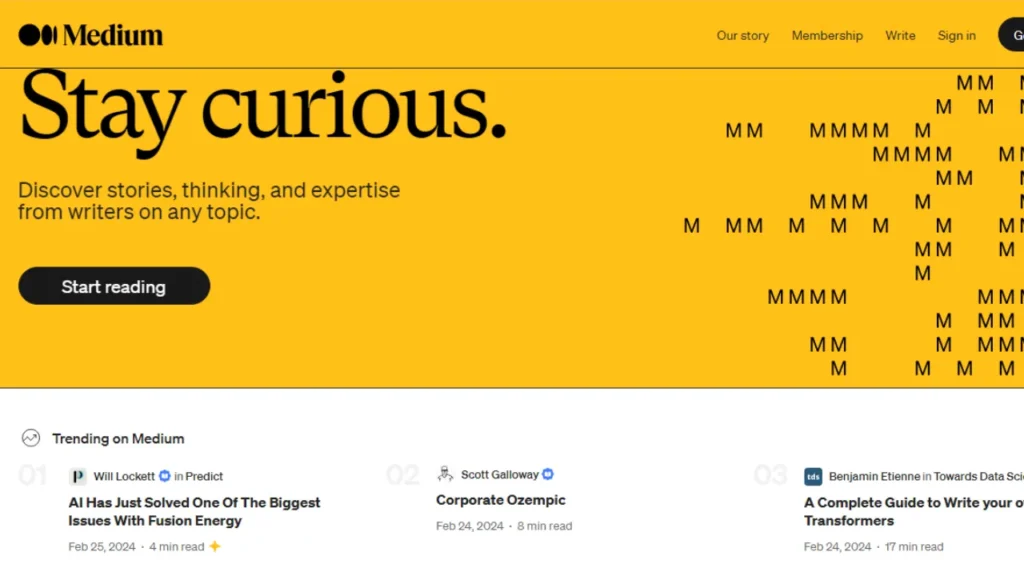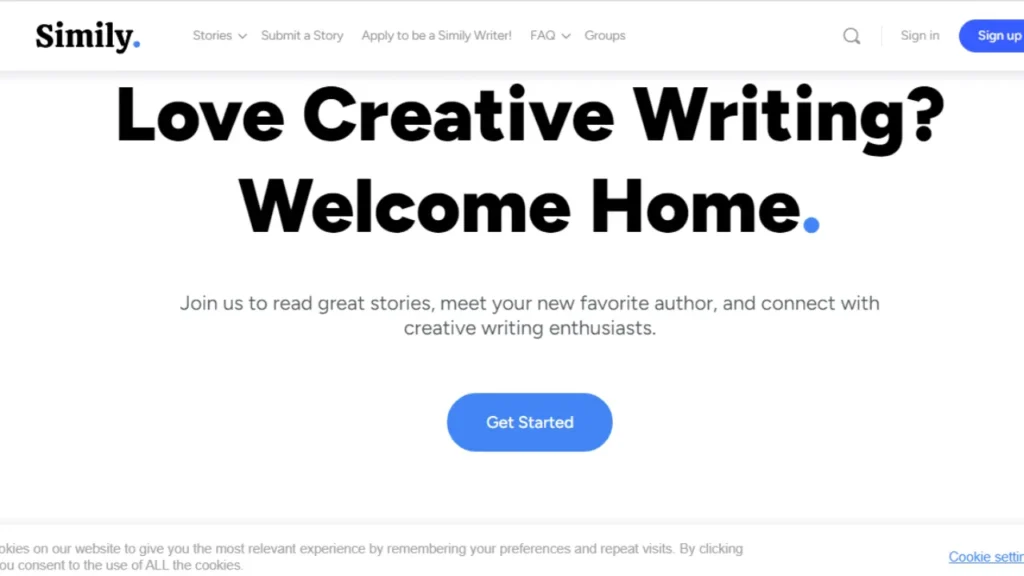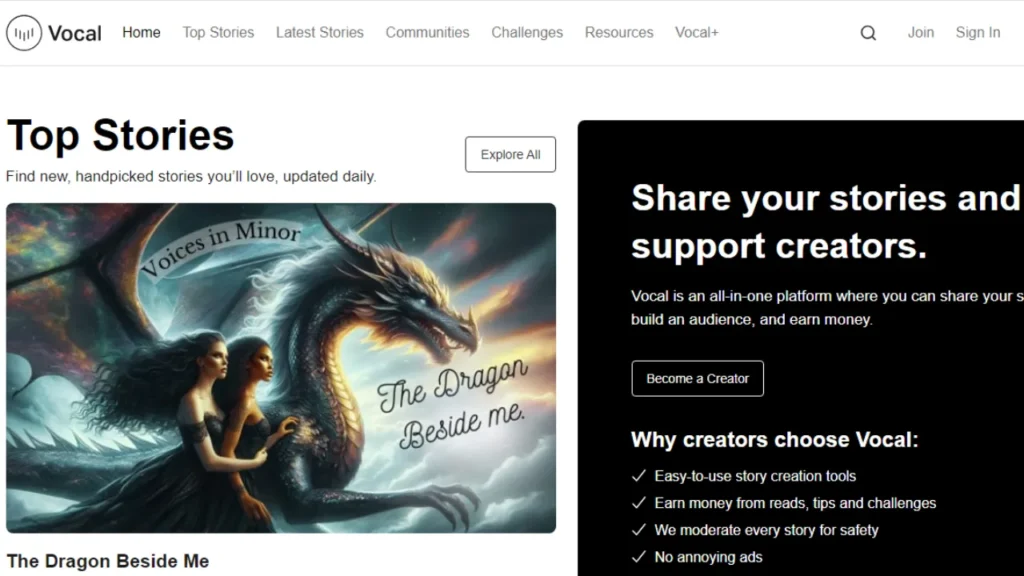So, you’re interested in exploring best writing platforms that offer opportunities for beginners to earn some income.
We’ll start by focusing on three platforms that function similarly to social media networks: you share your content, and your earnings are based on the views you receive.
Additionally, we’ll discuss two other platforms that operate more like job boards, where you can take on writing tasks from clients.
Throughout this article, we’ll examine the pros and cons of each platform and provide a comprehensive overview of how they work.
Let’s get started without delay!
5 Best Writing Platforms for Beginners
Medium

Medium functions uniquely: think of it as a blend between a social media platform like Twitter and a blogging platform like WordPress, with a twist – you earn money when your posts are read.
So, while the analogy may not be perfect, the beauty lies in its simplicity: you share your content, and users on Medium, regardless of whether they follow you, can discover and engage with it.
Each time a paying member reads your article, you receive a portion of their membership fee.
For writers, the aim is to create content that resonates well with the audience.
As for readers, they’re entitled to two complimentary stories per month, with an option to access more by subscribing for five dollars monthly.
This subscription revenue directly contributes to the earnings of writers. Its ad-free environment sets Medium apart, fostering a direct relationship between writers and readers. Quality content is rewarded with engagement and earnings, making it an exceptional platform for creators.
Earnings on Medium are primarily based on views.
Many writers I know have begun earning money relatively quickly. Typically, writers receive around two cents per view, roughly twenty dollars per thousand views.
Getting started on Medium is remarkably simple. All you need to do is sign up with your email, craft a profile, and start writing.
The beauty of Medium lies in its accessibility – the entry bar is set low. You could have your first story published today.
However, earning requires a bit more effort. There’s a threshold of 100 followers to meet before you can start earning. Achieving this milestone may take time, especially if you aim for rapid growth. I recommend actively engaging with the community:
- Leave thoughtful comments on others’ work.
- Follow writers whose content you enjoy.
- Contribute to various publications.
- Broaden your reach organically.
While some may resort to “follow for follow” tactics, focusing on genuine engagement yields better results in the long run. Building a natural following of around 100 followers is a solid starting point for budding writers on Medium.
Pros of Medium
One of the greatest advantages of Medium is the freedom to write about virtually anything you desire. Whether it’s feline adventures, globetrotting tales, or delving into the depths of fiction and poetry, Medium welcomes diverse topics ranging from self-help to psychology to feminism.
With its vast and diverse reader base, there’s an audience for every niche imaginable. The platform’s expansive reach ensures that your content can reach interested readers, regardless of the subject matter.
Cons of Medium
While Medium offers many opportunities for writers, there are some hurdles to overcome. Firstly, to earn money, you’ll need to amass a minimum of 100 followers, which can be time-consuming.
Earning a substantial income on Medium isn’t a get-rich-quick scheme; it requires dedication and patience. Additionally, as an audience-paid platform, the demand for content often dictates what gets noticed. While you can explore various topics, it’s essential to note that subjects related to health, wealth, and love tend to garner the most attention and engagement.
Another drawback is Medium’s payment system, which operates exclusively through Stripe. Unfortunately, Stripe only supports transactions in approximately 40 countries worldwide. This limitation means that writers residing in the remaining 150 countries may encounter difficulties receiving payment through the platform. It’s a significant setback, and one can only hope for a change in policy from both Medium and Stripe shortly.
Simily

Let’s explore Simily, the second platform on our list, which offers a unique space for creative writers to thrive.
Unlike Medium, where creative writing may not always yield significant earnings due to audience preferences, Simily is specifically tailored for creative content creators.
Simily offers a promising platform for fiction writers and creative storytellers to share their work and engage with readers. Whether you’re looking to explore new ideas or connect with an audience for your creative writing, Simily provides an avenue for expression and potential earnings.
Similar to Medium, Simily compensates writers at two cents per view. This means that for every thousand views your content receives, you earn $20.
Getting started on Simily is straightforward: join the platform, create your profile, and begin sharing your creative pieces. There’s no waiting period or minimum follower requirement; you can publish your first post immediately and earn money based on the views your content accrues.
Simily presents an exciting opportunity for writers who excel in creative storytelling to monetize their work and connect with an audience that appreciates their craft. Whether passionate about crafting fictional worlds or sharing personal narratives, Simily offers a supportive community and a platform to showcase your talent while earning a tangible income.
Pros of Simily
One of the standout advantages of Simily is its user-friendly interface, making it incredibly easy for beginners to get started on the platform.
Whether you’re new to writing or a seasoned storyteller, Simily provides a welcoming environment for creative expression. Moreover, Simily fills a crucial niche by offering a platform specifically designed for fiction and creative content writers.
In an online landscape where opportunities for paid creative writing are limited, Simily stands out by catering to this demand and providing a space for writers to share their imaginative works while earning compensation.
Another noteworthy aspect of Simily is its transparent payment model. Writers receive a fixed rate of two cents per view, providing clarity and predictability regarding their earnings. This straightforward approach allows writers to gauge their potential income based on the number of views their stories receive, fostering confidence and motivation.
Cons of Simily
Despite its many strengths, Simily has its share of challenges.
One notable concern is the lack of clarity regarding how stories are promoted to readers and how readers discover content on the platform. The absence of transparent algorithms or promotion strategies leaves writers uncertain about the visibility of their work and the factors influencing their story’s reach.
Additionally, Simily imposes a minimum payout threshold of 10 dollars, requiring writers to accumulate at least 500 views before they can receive payment. While this threshold is attainable, it may pose a barrier for writers with smaller audiences or those just starting on the platform.
Furthermore, the platform’s business model, particularly its payment structure, is subject to change. While Simily currently offers a competitive rate of two cents per view, this could be modified in the future, potentially impacting writers’ earnings.
Vocal

Vocal is an interesting platform, like a blend of Simile and Medium.
While it may not offer as much creative freedom as Simile, it surpasses Medium.
Here’s how it operates: you sign up, start writing, publish your stories, and earn based on views.
Unlike Simile and Medium, Vocal relies more on ad revenue than membership fees. You earn six dollars per 1000 views, which is lower than other platforms. This rate applies if you’re part of the Vocal Plus program, which costs ten dollars monthly. If you’re not part of it, the rate is even lower, around three or four dollars monthly.
Despite the modest earnings, Vocal stands out with its unique feature: writing challenges. These challenges involve responding to prompts with a minimum word count and specific guidelines.
The prizes for these challenges can be substantial, with winners sometimes earning up to twenty thousand dollars.
So, while the regular earnings may not be extraordinary, Vocal offers the potential for significant rewards through its writing challenges, making it an intriguing platform for writers seeking both exposure and opportunities for substantial payouts.
Pros of Vocal
Vocal offers a straightforward entry point for beginners.
While there’s a bit more of a submission process compared to Medium and Simile, it’s not overly complicated.
On Vocal, you need to submit your story, which undergoes checks for plagiarism and inappropriate content before being published. This process typically results in a 10 to 12-hour delay before your story goes live.
Additionally, Vocal provides alternative avenues for earning money beyond just views. Unlike Medium, you earn from both member and non-member views since Vocal relies more on ads for revenue. This means you get paid for every view, regardless of the viewer’s membership status, albeit at a slightly lower rate compared to Simile and Medium.
Cons of Vocal
One downside is that the rubric for winning challenges on Vocal can sometimes be unclear. Occasionally, winners may not fully adhere to the rubric, leading to confusion among participants.
Another aspect that may deter some writers is the Vocal Plus subscription model. It feels counterintuitive that you have to pay to earn money, which might seem off-putting to some users.
So, we’ve discussed three writing platforms that compensate based on audience engagement. The basic idea behind all three is simple: you publish content, it attracts views, and you start earning money.
Each platform does have its minimum payout threshold. For Vocal, you need to reach 35 dollars before you can cash out, while for Medium and Simile, it’s just 10 dollars. Nevertheless, if you understand your audience well, you can consistently write content and generate income through people reading your work, which is awesome.
Now, let’s shift our focus to a different type of writing platform that caters to beginners: job boards. I’ll discuss two such platforms, starting with one called Scripted.
Scripted

I recently joined Scripted, and I am thrilled to share my experience with you.
Let’s dive into how Scripted works—it’s pretty straightforward. Think of it like any other job board: you apply, and Scripted reviews your application. If they think you’re a good fit, welcome aboard! If not, no worries; there are plenty of other opportunities out there.
Once you’re in, you gain access to various writing gigs posted by clients. But let’s break down the process step by step. First things first, you need to apply and get accepted. Scripted prides itself on maintaining high standards, accepting roughly five percent of applicants. It might sound daunting, but don’t fret.
Now, about the application test—it’s not too bad. Sure, it’s heavy on grammar, but you can ace it with a bit of effort. My advice? Take your time, use Google if needed (I did!), and use the resources provided. Trust me, it’s worth the effort.
Once you’re in, it’s portfolio time. Take this seriously because it’s how you’ll land gigs. Upload your best writing samples and showcase your expertise. If you’re new to this, no worries—start small with a few articles in industries you’re interested in, like healthcare or finance, and use platforms like Medium for a free portfolio.
Once your profile is set, it’s time to start earning. Scripted offers three ways to make money through writing gigs.
Method One: Smart Match Job Invites
Picture this: a client drops a project brief on Scripted’s desk, and the platform, powered by what seems like AI magic, sifts through portfolios to find the perfect match.
If you’re lucky, that invite lands in your inbox, along with a handful of other writers.
Here’s the catch—it’s a race against the clock. Blink, and you might miss it. The first writer to hit accept scores the gig, no questions asked. It’s like the Olympics of freelancing, but instead of medals, you get paid.
Remember, while the rates may lean towards the modest side, consider it a surefire paycheck.
Method Two: Job Invites with a Twist
Imagine a client waving a project idea in the air, asking, “Who’s up for the challenge?” Scripted rounds up a crew of potential wordsmiths—maybe 10, maybe 20—and throws the ball back in their court.
You craft a proposal, toss it into the ring, and wait. It’s a bit like a game of literary hot potato. The client picks through the proposals, but don’t hold your breath—a response could take up to two weeks.
Yet, there’s a silver lining: you get to name your price and showcase your expertise in the proposal, giving you more control over the process.
Method Three: Classic Job Board Style
Lastly, there’s the traditional approach—good ol’ job listings. Clients drop their projects on the platform, and it’s open season for writers. You can browse the offerings, tossing your hat into the ring for the ones that catch your eye.
Whether pitching your own ideas or tackling the client’s brief head-on, this method offers a bit more flexibility in how you approach your work.
Pros of Scripted
Let’s talk about what makes Scripted shine! First, they set a floor for payment—no less than seven cents per word. Now, that’s not something you come across every day, right? It’s a game-changer, and it shows they value your skills.
Another thing I love is the range of opportunities available. Whether you’re into healthcare, finance, or something entirely different, Scripted has clients from all walks of life. It’s like a buffet of writing gigs—something for everyone.
And here’s the kicker: the quality of clients. I’ve spotted folks who’ve been hanging around Scripted for years. That speaks volumes about the trust writers and clients have in the platform. It’s a solid relationship all around.
Cons of Scripted
Now, onto the flip side. Getting accepted into Scripted can be a challenge. With only one out of twenty writers making the cut, it’s no walk in the park.
Then there’s the timing—it’s like a rollercoaster. One moment, you’ve got a mere two minutes to snatch up a job, and the next, you’re twiddling your thumbs for two weeks, waiting to hear back. Talk about a whirlwind!
Another thing to note is the upfront work required for many gigs. You might spend time crafting a killer proposal only to find no payout. It’s a risk you’ll have to weigh.
Oh, and don’t forget about the portfolio—you’ll need some solid articles to strut your stuff.
In a nutshell, Scripted is a fantastic starting point for budding writers. You don’t need a sprawling portfolio, just targeted content. Plus, they’re all about ensuring fair pay, which I can get behind.
Textbroker

Textbroker operates much like Scripted, starting with the application process.
Once you apply, you’re given a star rating—ranging from one to five—based on your skills. The higher your rating, the more lucrative the gigs you can snag.
On the client side, they can post job briefs to the board and specify their star rating preference. As a three-star writer, I was limited to applying for jobs of that rating or lower, which was a bit of a bummer.
Now, let’s talk about the green stuff—you can earn in three ways on Textbroker. First up, you’ve got the job board gigs. These are straightforward—you see a job you like, take it, do the work, and get paid. Easy peasy. They’re usually quick and punchy tasks, nothing too labor-intensive, but they don’t pay much.
Next, you can score a direct hire from a client. Clients who dig up your style might handpick you for future jobs. They’ll send the work your way, you do your thing, and cha-ching, payday!
And then there’s option number three: team assignments. One time, a client hit me up, was impressed with my work, and invited me to join their team for similar projects. It sounded promising, even though it didn’t pan out for me.
Pros of Textbroker
Textbroker offers a straightforward and accessible platform for writers to find work. The star rating system clarifies job qualifications, with higher ratings unlocking access to better-paying opportunities. This structure allows writers to gauge their progress and strive for higher ratings.
The variety of payment options is a major plus. Writers can choose from three ways to earn: by accepting jobs from the job board, being directly hired by clients, or joining specialized teams. This flexibility caters to different preferences and work styles, ensuring writers can find the right fit for their skills and availability.
Direct client hires and team invitations offer opportunities for ongoing work and building long-term relationships with clients. This can lead to more consistent income and a sense of stability for writers.
Cons of Textbroker
One downside of Textbroker is the limitation imposed by star ratings. Writers may find themselves restricted to lower-paying jobs if they have a lower star rating, which can be disheartening and may not accurately reflect their skills or potential.
While the job board provides quick and easy access to short, simple tasks, these jobs often come with low pay rates. Writers may need to complete a high volume of these tasks to earn a substantial income, which can be time-consuming and not sustainable in the long run.
Although direct client hires and team invitations present promising opportunities, consistent work or success is not guaranteed. Writers may accept offers but receive little to no work from clients or teams, leading to uncertainty and disappointment.
Overall, Textbroker offers a convenient platform for writers to find paid writing opportunities, but it’s important for writers to carefully consider the limitations and potential challenges associated with the platform.
Wrapping Up
To sum up, all five of these platforms offer legitimate opportunities to get paid for writing. While none of them are likely to make you a millionaire, they serve as valuable stepping stones, especially for beginner writers eager to gain experience and establish themselves in the field.
From my own experience, earning potential typically ranges within the realm of a few hundred to a thousand dollars per month on these platforms.
Even if you’re not aiming for a full-time writing career, they can still be a fruitful side hustle for earning extra cash. Whether you’re pursuing writing as a passion or simply looking to supplement your income, these platforms provide accessible avenues.
If you have any questions or need further clarification, please drop them in the comments below. I’m here to help!

